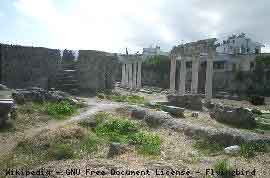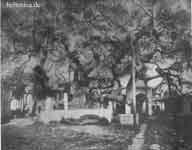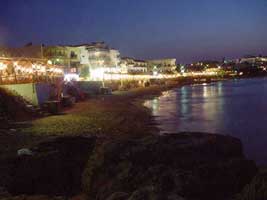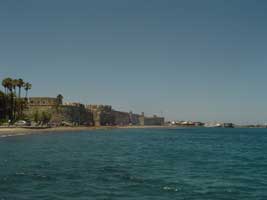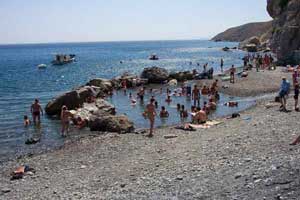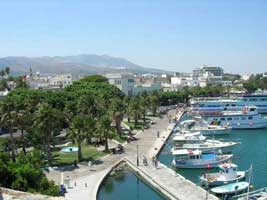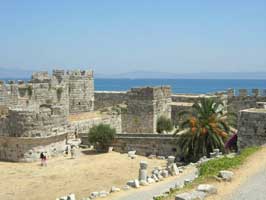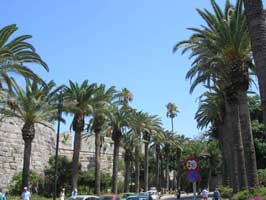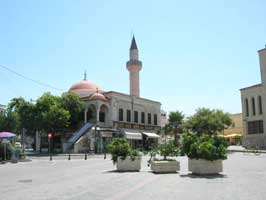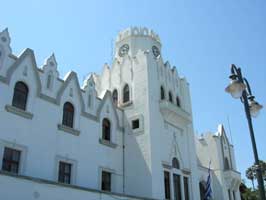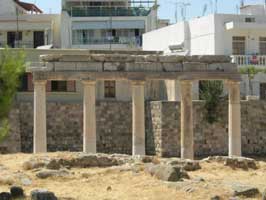Administrative Region : North Aegean
Regional unit : Kos
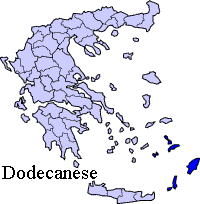 |
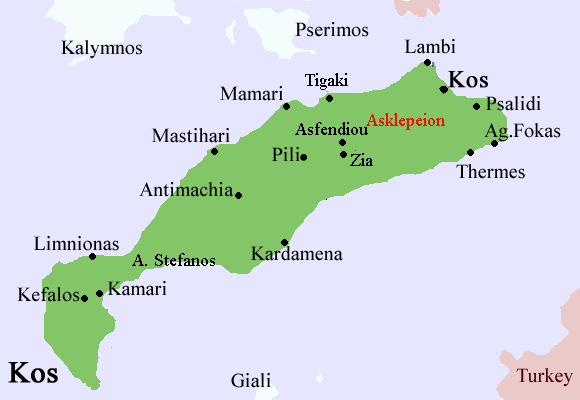 |
Kos or Cos (Greek: Κως) is a Greek island in the south Sporades group of the Dodecanese, next to the Gulf of Gökova/Cos. It measures 40 kilometres (25 mi) by 8 kilometres (5.0 mi), and is 4 kilometres (2.5 mi) from the coast of Bodrum, Turkey and the ancient region of Caria. Administratively the island forms a separate municipality within the Kos peripheral unit, which is part of the South Aegean Periphery. The principal town of the island and seat of the municipality is Kos town.[1] The island has a population of 30,947.
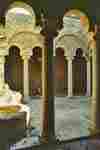
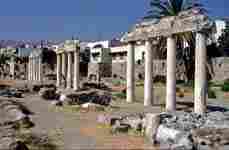

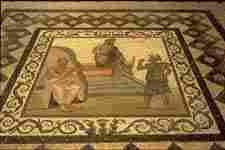
Name
The island has been known as Kos in Greek throughout its history. A person from Kos is called a "Koan" in English (Greek: Kώτης). The word is also a possessive, as in "Koan goods".[2] Kos has also been called İstanköy by the Ottomans, Coo by the Italians, and was formerly known as Stanchio in English.
|
Archaeological site [Source] |
|
Municipality
The present municipality Kos was formed at the 2011 local government reform by the merger of the following 3 former municipalities, that became municipal units:[1]
Dikaios
Irakleides
Kos

History
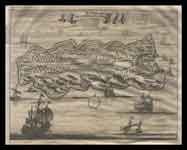
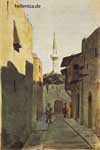
Further information: Ancient Greece, Roman Greece, Byzantine Greece, and Ottoman Greece
View of the Asclepeion.
Ruins of the Ancient Gymnasium.
View of the ancient Odeon.
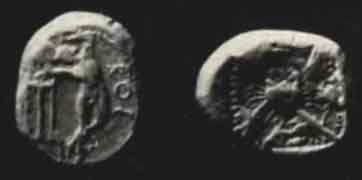
Kos Tetradrachm, Discobolus with Tripod a prize of the athletic contest of the Dorian cities in the region. Text "KOS", Crab, 5th century BC
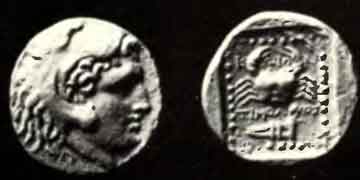
Kos Tetradrachm, Heracles Head with lion skin, Crab with Text "KOION" and "TIMOLYKOS". after 300 BC
The island was reportedly visited by Hercules, in the Roman mythology.[3]
The island was originally colonised by the Carians. A contingent from Kos participated in the War of Troy[4] The Dorians invaded it in the 11th century BC, establishing a Dorian colony with a large contingent of settlers from Epidaurus who took with them their Asclepius cult and made their new home famous for its sanatoria. The other chief sources of the island's wealth lay in its wines, and in later days, in its silk manufacture.[5]
Its early history as part of the religious-political amphictyony that included Lindos, Kamiros, Ialysos, Cnidus and Halicarnassus, the Dorian Hexapolis (Greek for six cities),[6] is obscure. At the end of the 6th century Kos fell under Achaemenid domination, but rebelled after the Greek victory at Cape Mykale in 479. During the Greco-Persian Wars, when it expelled the Persians twice, it was ruled by tyrants, but as a rule it seems to have been under oligarchic government. In the 5th century it joined the Delian League, and after the revolt of Rhodes served as the chief Athenian station in the south-eastern Aegean (411-407). In 366 BC, a democracy was instituted. After helping to weaken Athenian power, in the Social War (357-355 BC), it fell for a few years to the king Mausolus of Caria. In 366 BC, the capital was transferred from Astypalaia to the new-built town of Kos, laid out in a Hippodamian grid plan.
Proximity to the East gave the island first access to imported silk thread. Aristotle (384 BC-322 BC) mentions silk weaving conducted by the women of the island.[7] Silk production of garments was conducted in large factories by women slaves.[8]
In the Hellenistic age Kos attained the zenith of its prosperity. Its alliance was valued by the kings of Egypt, who used it as an outpost for their navy to watch the Aegean. As a seat of learning it rose to be a kind of provincial branch of the museum of Alexandria, and became a favorite resort for the education of the princes of the Ptolemaic dynasty; among its most famous sons were the physician Hippocrates, the painter Apelles, the poets Philitas and, perhaps, Theocritus.
Kos was also known as Meropis and Nymphæa. Diodorus Siculus (xv. 76) and Strabo (xiv. 657) describe it as a well-fortified port. Its position gave it a high importance in Ægean trade; while the island itself was rich in wines of considerable fame (Pliny, xxxv. 46). Under Alexander III of Macedon and the Egyptian Ptolemies(from 336 B.C.) the town developed into one of the great centers in the Ægean; Josephus ("Ant." xiv. 7, § 2) quotes Strabo to the effect that Mithridates was sent to Kos to fetch the gold deposited there by the queen Cleopatra of Egypt. Herod is said to have provided an annual stipend for the benefit of prize-winners in the athletic games (Josephus, "B. J." i. 21, § 11), and a statue was erected there to his son Herod the Tetrarch ("C. I. G." 2502 ). Paul briefly visited here according to (Acts 21:1).
Except for occasional incursions by corsairs and some severe earthquakes, the island has rarely had its peace disturbed. Following the lead of its great neighbour, Rhodes, Kos generally displayed a friendly attitude towards the Romans; in 53 AD it was made a free city. Lucian (125-180) mentions their manufacture of semi-transparent light dresses, a fashion success.[9]
The island was later conquered by the Venetians, who then sold it to the Knights Hospitaller of Rhodes (the Knights of St John) in 1315. Two hundred years later the Knights faced the threat of a Turkish invasion and abandoned the island to the Ottoman Empire in 1523. The Ottomans ruled Kos for 400 years until it was transferred to Italy in 1912. In World War II, the island was taken over by the Axis powers. It was occupied by Italian troops until the Italian surrender in 1943. British and German forces then clashed for control of the island in the Battle of Kos, in which the Germans were victorious. German troops occupied the island until 1945, when it became a protectorate of the United Kingdom, who ceded it to Greece in 1947.
The Market - Agora
View of the municipal market.
The Market place of Kos was considered one of the biggest in the ancient world. It was the commercial and commanding centre at the heart of the ancient city. It was organized around a spacious rectangular yard 50 metres (160 ft) wide and 300 metres (980 ft) long. It began in the Northern area and ended up south on the central road (Decumanus) which went through the city. The northern side connected to the city wall towards the entrance to the harbour. Here there was a monumental entrance. On the eastern side there were shops. In the first half of the 2nd century BC the building was extended towards the interior yard. The building was destroyed in an earthquake in 469 AD.
In the southern end of the Market there was a round building with a Roman dome and a workshop which produced pigments including “Egyptian Blue”. Coins, treasures, and copper statues from Roman times were later uncovered by archeologists. In the western side excavations led to the findings of rooms with mosaic floors which showed beastfights, a theme quite popular in Kos.[10]
Geography
Map of Kos by Olfert Dapper, Amsterdam, 1702.
Map of Kos.
The island is part of a chain of mountains from which it became separated after earthquakes and subsidence that occurred in ancient times. These mountains include Kalymnos and Kappari which are separated by an underwater chasm c. 70 m (40 fathoms deep), as well as the volcano of Nisyros and the surrounding islands.
There is a wide variety of rocks in Kos which is related to its geographical formation. Prominent among these are the Quaternary layers in which the fossil remains of mammals such as horses, hippopotami and elephants have been found. The fossilised molar of an elephant of gigantic proportions was presented to the Paleontology Museum of the University of Athens.
The shores of Kos Island are washed by the waters of the Aegean Sea. Its coastline is 112 km long and is caressed by long immaculate beaches, leading to its main industry being tourism. Farming is the principal occupation of many of the island's inhabitants, with their main crops being grapes, almonds, figs, olives, and tomatoes, along with wheat and corn. Cos lettuce may be grown here, but the name is unrelated.
The main villages of Kos island are Kardamena, Kefalos, Tingaki, Antimachia, Mastihari, Marmari and Pyli. Smaller ones are Zia, Zipari, Platani, Lagoudi and Asfendiou.
Culture
The harbour of Kos (city).
The Cathedral of the city of Kos.
Asfendiou Monastery of Zia.
Hippocrates' statue.
The main port and population centre on the island, also called Kos, is also the tourist and cultural centre, with whitewashed buildings including many hotels, restaurants and a small number of nightclubs forming the famous Kos town "barstreet". The town has a 14th century fortress at the entrance to its harbour, erected in 1315 by The Knights of Saint John of Rhodes.
The ancient physician Hippocrates is thought to have been born on Kos, and in the center of the town is the Plane Tree of Hippocrates, a dream temple where the physician is traditionally supposed to have taught. The limbs of the now elderly tree are supported by scaffolding. The small city is also home to the International Hippocratic Institute and the Hippocratic Museum dedicated to him. Near the Institute are the ruins of Asklepieion, where Herodicus taught Hippocrates medicine. Kardamena is a popular resort for young British holidaymakers and has a large number of bars and nightclubs.
Religion
The main religion practiced is Greek Orthodoxy. Kos has one of the four cathedrals in the entire Dodecanese. There is also a Roman Catholic Church on the island as well as a Mosque catering to the Muslim community of Kos. The Synagogue is no longer used for religious ceremonies as the Jewish community of Kos was practically wiped out by the Nazis in World War II. It has, however, been restored and is maintained with all religious symbols intact and is now used by the Municipality of Kos for various events, mainly cultural.
Notable people
Hippocrates (5th century BC), "father of medicine".
Apelles (4th century BC), painter.
Michael Kefalianos, professional bodybuilder.
Marika Papagika, early 20th century singer.
Al Campanis, (20th century) Major League Baseball player and executive.
Stergos Marinos, international footballer currently playing for Panathinaikos.
See also
List of volcanoes in Greece
References
^ a b Kallikratis law Greece Ministry of Interior (Greek)
^ Kos Island Today
^ Hercules in Kos
^ Iliad ii.676, from "Kos, the city of Eurypylus, and the Calydnae isles", under the leaders Phidippos and Antiphos, "sons of the Thessalian king". It is unclear whether Homer is describing cultural affiliations of his own time or remembered traditions of Mycenaean times.
^ Money, Power and Gender:EVIDENCE FOR INFLUENTIAL WOMEN REPRESENTED AND SCULPTURE ON KOS
^ The Princeton Encyclopedia of Classical Sites (eds. Richard Stillwell, et al.), s.v. "Kos".
^ A Treatise on the Origin, Progressive Improvement, and Present State of the Silk Manufacture
^ Introduction to the New Testament
^ Kos
^ Ancient Sites of the Harbour and Market Place
|
The Dodecanese Islands Agathonissi | Koubelonisi | Stroggyli | Farmakonisi | Arkoi | Kalovolos | Agreloussa | Anydros Patmou | Patmos | Hiliomodi Patmou | Tragonisi | Arefoussa | Leipsoi | Megalo Aspronisi Leipson | Makry Aspronisi Leipson | Kouloura Leipson | Makronisi Leipson | Halavra | Imia | Fragos | Arhangelos | Faradonesia | Leros | Piganoussa | Pitta | Megalo Glaronisi | Mikro Glaronisi | Kalymnos | Kalolimnos | Kalavros Kalymnou | Telendos | Nero | Safonidi | Plati Pserimou | Pserimos | Levitha | Mavra Levithas | Glaros Kinarou | Kinaros | Kos | Gyali | Nisyros | Pergoussa | Paheia Nisyrou | Kandeloussa | Tilos | Antitilos | Gaidourosnissi Tilou | Seirina | Mesonisi Seirinas | Adelfoi Syrnas Islets | Kounoupoi | Koutsomytis | Hondro | Astypalaia | Fokionissia | Pontikoussa | Symi | Nimos | Marmaras | Kouloundros | Plati Symis | Sesklio | Chalki | Agioi Theodoroi Halkis | Alimia | Makry Halkis | Prasouda | Rhodos | Strogulli Kritinias | Htenies | Karavolas Rodhou | Prasonissi Rodhou | Megalo Sofrano | Mikro Sofrano | Astakida | Kamilonisi | Saria | Karpathos | Kasos | Armathia | Makronissi Kassou | Rho | Kastellorizo (Megisti) | Stroggyli Kastellorizou |
Greece :
A - B - C - D - E - F - G - H - I - J - K - L - M -
N - O - P - Q - R - S - T - U - V - W - X - Y - Z
Retrieved from "http://en.wikipedia.org/"
All text is available under the terms of the GNU Free Documentation License
| Ancient Greece
Science, Technology , Medicine , Warfare, , Biographies , Life , Cities/Places/Maps , Arts , Literature , Philosophy ,Olympics, Mythology , History , Images Medieval Greece / Byzantine Empire Science, Technology, Arts, , Warfare , Literature, Biographies, Icons, History Modern Greece Cities, Islands, Regions, Fauna/Flora ,Biographies , History , Warfare, Science/Technology, Literature, Music , Arts , Film/Actors , Sport , Fashion --- |

